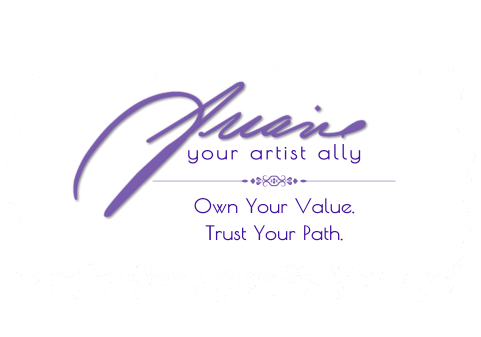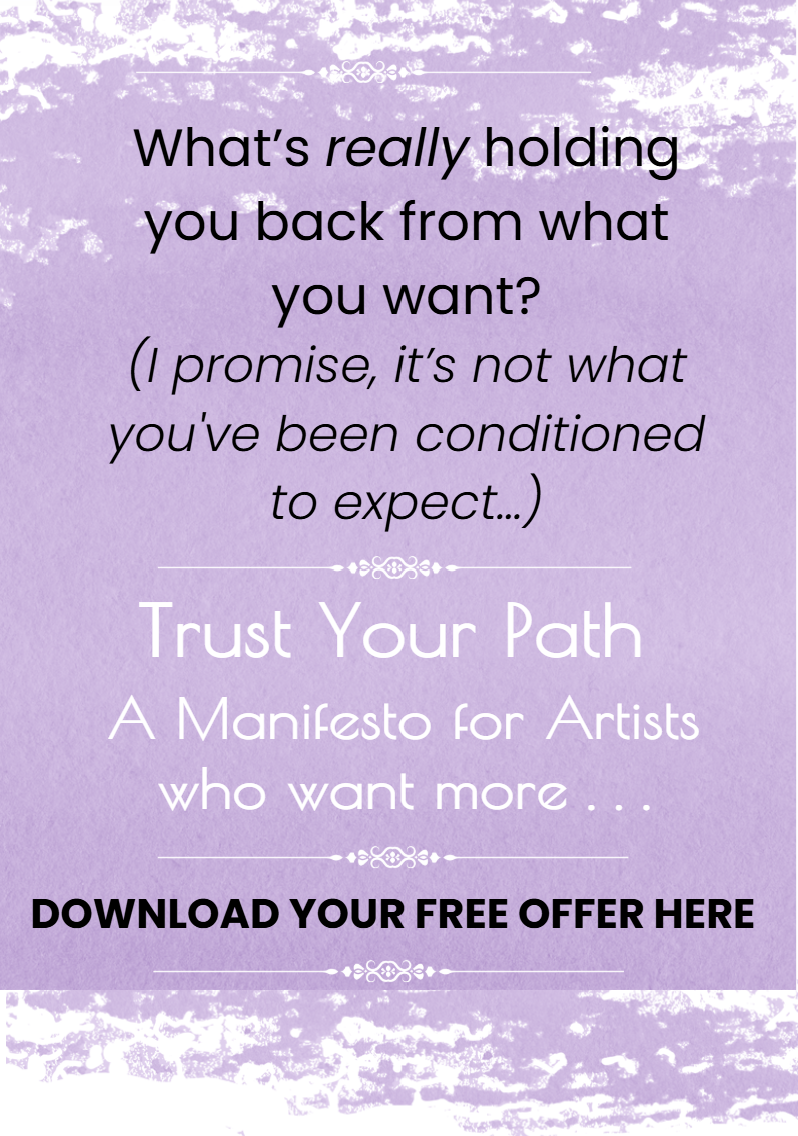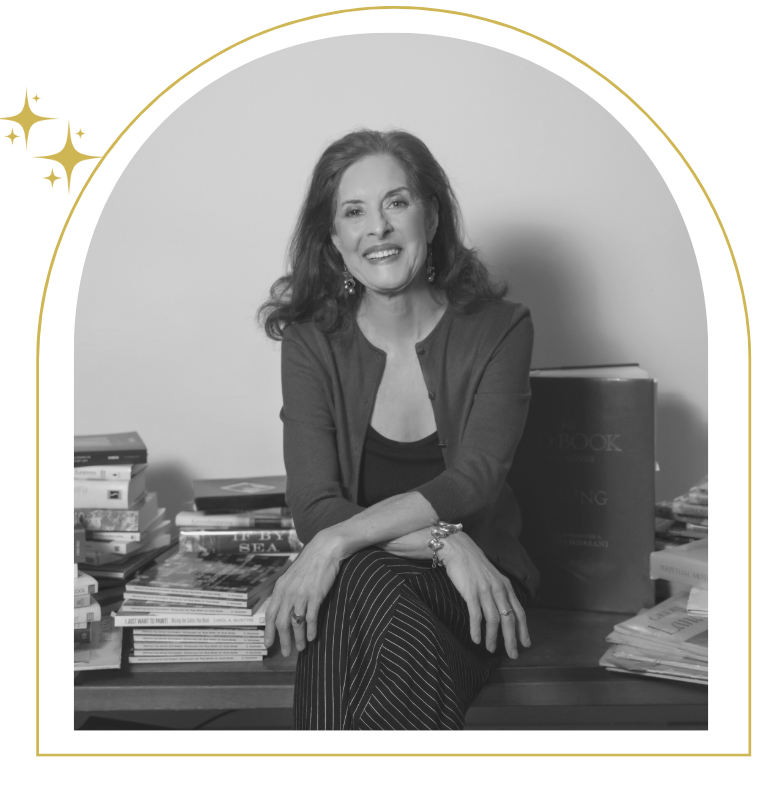Let’s define our terms, shall we?
Before spring planting, I like to pull out weeds first. Sometimes definitions need this too.
Artist Statement:
Weed pulling… what it’s not.
It’s not: a bio, a resume, or a personal critique.
Planting…
Your Artist Statement is a process where word-language reinforces the visual language of your art.

Because we are all hardwired for visual and word languages, believing one is more powerful or important than the other burns down one of the most powerful bonds you can have with your viewers. Full stop.
Artistic Fingerprint:
Weed pulling… what it’s not.
It’s not your artistic voice (unless you’re planning an Off Broadway review).
It’s not your artistic style (unless you’re planning a runway collaboration during Fashion Week.) (Or you want to know where your work is on the historical art styles spectrum).
Planting…
You Artistic Fingerprint is what distinguishes you from the thousands of other artists all vying for visibility. It’s the X factor in every, single piece you create that tells anyone that you, and you alone, made this.
And like your literal fingerprint, no one else can truly duplicate what you do.
Besides the fact that most artists create their work, in some aspect or other, with their hands, a finger’s fingerprint is also a visual clue—not auditory, or kinesthetic, but physically visual.
The Artist Statement Half of… The Ultimate Power Couple for Selling Your Art
Here are two, little-understood, artist statement secrets: About Them and About You.
Secret #1 About Them: the people who see your art, who are moved by your art, and then immediately experience a very human desire to want more.
And the more they want is …
Secret #2 About You: the artist who gave them this moving emotional, aesthetic experience.
Sure, they can stand there, shifting from one foot to the other (or move their cursor around), and stare some more. Maybe even strike up a conversation with someone next to them about what they are seeing and feeling and thinking: Honey, come look at this. What do you think?
Sure, you can leave it up to them to wander into this never-never land of your art and take what from it what they will, until they move onto the next piece (maybe one of yours, maybe not).
Alternately, you could give them a killer artist statement that keeps them right there, next to your work, contemplating it even more. Spending more time with the experience your work has triggered for them.
Because, when you capture that next layer of insight and awareness – without detracting from your viewer’s perspective – you have built a psychological bridge between you (the artist) and your potential buyer.

Ah, you may be thinking, but how do I write an artist statement that doesn’t interfere with what my viewer is experiencing? Isn’t putting my spin on my work already inserting myself into their experience?
As it turns out, many artists I’ve worked don’t bother with the open-ended curiosity of a question, but go right for the declaration: I won’t write my artist statement because… I want my viewer to draw their own conclusions. I don’t want to interfere or impose on their interpretation or experience.
I totally get it. This resistance to writing an artist statement feels utterly reasonable, especially to those of us who already worry about inconveniencing or “bothering” someone else.
However, this misplaced concern completely misses the point of an artist statement, which is not an explanation of what your work means, or a roadmap to what someone should be experiencing when they see it.
If you want to dive into why this declaration is not actually protecting any viewer from anything, check out this blog post: Your Artist Statement… Why Bother? Part 1: Four Rational Reasons To Not Write An Artist Statement.
If you are doing it right, your artist statement is not telling, or explaining, it’s revealing your relationship to the piece they’re viewing.

An effective artist statement is all About Them, about extending the experience you are creating for them!
It is about giving them a precious, word-language context that bonds to the visual-language you and your art have created.
It’s letting your viewer in on some aspects of your private relationship to your work, which, when done well, brings your viewer closer to the piece they are experiencing because they feel closer to you, the artist.
At the Core of Artist Statement Secret #1: About Them
… lies an uncomplicated truth: an effective statement creates a personal connection to your artwork because it stimulates our human thirst for story.

This, in turn, triggers longer memory storage about you and your work by immersing the viewer in not just one, but two languages essential to our human experience: visual and linguistic.
At The Core Of Artist Statement Secret #2: About You
This secret is a bit sneaky because it’s not at all what people think an artist statement is for.
Besides the art patrons, gallery owners, residencies (and a dozen other applications), your artist statement is for you. Not the marketing-business you, but you the artist.
Writing an artist statement gives you another way to reflect on your work. When you dare to climb this small, professional Mt. Everest, a surprising view of your own work awaits you at the top.
The very effort of searching for words that truly, authentically reflect your relationship to your art increases your creative flow.
This is true whenever we engage in a form of self-expression that pushes us out of our comfort zone. Like sweat from physical exertion, the very struggle gets our creative juices flowing.
One of the great keys of creativity is to shake things up, get out of familiar mindsets, work against the grain. Sometimes it is hard for an artist — whose artwork is based on uniqueness — to realize how easy it is for any pattern to become familiar.
Writing your artist statement — the what, how, and why of your work — will draw art buyers closer to your work even as it deepens your own awareness.
As another sculptor, Norbert Ohnmacht, learned:
Writing my artist statement gave me a chance to focus on myself. It opened up more creative juice and self-expression than I had experienced in a long time. Taming my internal critic, and the roadblocks to my inner mind, gave me new skills to express my heartfelt emotions to others.
Working on my statement gave me the opportunity to delve into my inner soul and reflect on the science of “me.” When I took the time to evaluate what, how and why I do what I do, it refined my work and gave me a fresh, determined self-confidence that I had lacked before.
The Other Half of…
The Ultimate Power Couple for Selling Your Art: Your Artistic Fingerprint
We are all deeply familiar with the sensation that we are unique; there is only one of me, and only one of you.
And yet, even though we live in a culture that elevates individualism over the collective, celebrating our uniqueness is discouraged by a whole host of admonishments:
It’s not polite to brag.
Who do you think you are?
So, you think you’re better than others…
There’s always someone more talented than you.
You’re stuck up.
You sure do have a high opinion of yourself!
And then there’s the disparity between women being confidently themselves and men:
You’re too loud.
You’re a bitch.
You’re too dramatic.
You talk too much.
Don’t step on anyone’s toes.
Don’t be a (fill in the blank)… slut, loudmouth, and so on…
Our rational minds may have learned to compensate for, or overcome, this pervasive, persuasive cultural negativity to the point where we truly believe we are free of its subconscious undertow.
And yet, for a whole host of artists, this cultural mindset has poisoned the well of their Original Uniqueness of their Original Selves—some more so, some less.
The result is either a fuzzy, incomplete, or completely missing artistic fingerprint because the uniqueness of who we are and the uniqueness of our artwork are intimately, and forever, entwined.
When an artist is highly skilled, talented even, and yet it’s impossible to tell their artwork apart from dozens of equally skilled artists with similar work, that’s what the world of card sharks would call “a tell.”
Often these artists have settled for the ohhs and ahhs of family and friends; or the creative high that goes hand-in-hand with the skillful execution of a piece. All the while denying the world a true slice of their unique soul.
As I’ve said before, and it bears repeating, repeating, repeating:
Artistic fingerprints are the soft underbelly of our creative ArtLife. The direct flow between your work and your creative soul depends upon the willingness and courage to be raw and vulnerable.
And this, in large part, needs the appropriate personal boundaries and safeguards in place so vulnerability becomes risky enough to break through old patterns, but safe enough to stay real.
Every artist I’ve ever met has told me of the moments where they felt elevated they had entered a timeless, seamless flow where there was no distinction between themselves, the piece they were working on, and the process of creating. It was all One.
The universality of this experience goes unquestioned. And yet, each artist’s creative efforts have pulled from this realm a piece that looks unlike any other piece anywhere. Creative paradox.
Like the fingerprints on your fingers, your Artistic fingerprint holds this intriguing, creative paradox: it is at once unique and universal–always a fingerprint… yet never the same.
Creative Magic: when you give yourself permission to mine the depths for that which is truly yours, you lead the way for others to know themselves in equal measure.
Whether or not they take you up on that is their business. Yours is to always shine the light on your Original True Self.

A Case Study For The Ultimate Selling Your Art Power Couple:
Your Artist Statement & Artistic Fingerprint
When one of my private clients held a solo exhibition of his sculpture, he followed my suggestion to display each, singular art statement, about an individual piece, alongside the artwork.
The typed statements were mounted at the top of thin, metal poles rising out of a stand to shoulder-height, so you could walk right up and read it. And because the font size was large enough, anyone else peering over someone’s shoulder could also read it.
I arrived at the opening early and made a point to be a fly on the wall. And what I saw truly surprised me. The oft-quoted truism—a picture is worth a thousand words—had all the air knocked out of it that night.
All evening, with its 200 plus guests, I watched the same scene unfold.
Someone would approach one of the sculptures, glance briefly at the piece, then immediately turn and read the entire art statement; some that were two or three paragraphs.
Then they would turn back, with an appreciative nod or smile, and really look at the sculpture, walk around it, talk about it, walk around it some more.
I could see on their faces how their brains first registered, and then organized, the words they read with the images they saw. I could literally see how the combination kept them engaged with each piece, and how it sparked conversations between the guests.
The result of that night was a selling-your-art success…
…and a triumph for the ultimate Power Couple for Selling Your Art:
Your Artistic Fingerprint and Your Artist Statement.
======================================================
If you are ready to write your ultimate artist statement, check out the all new, updated 3rd Edition of my eBook: Writing The Artist Statement: Revealing The True Spirit of Your Work









